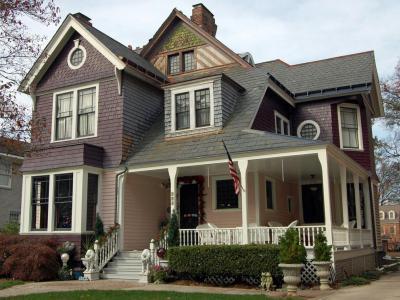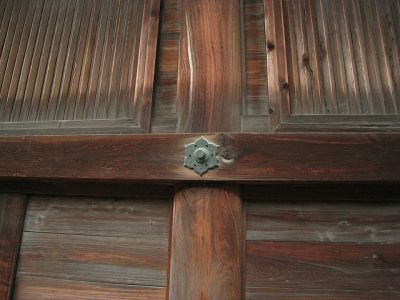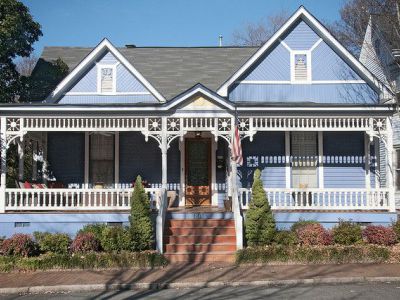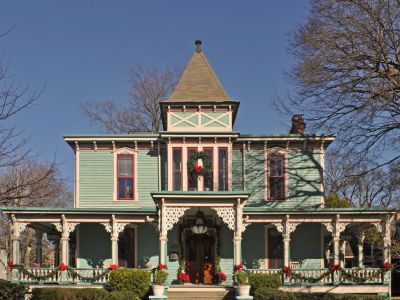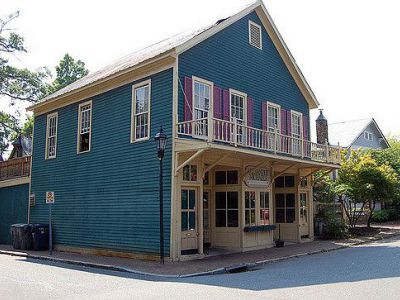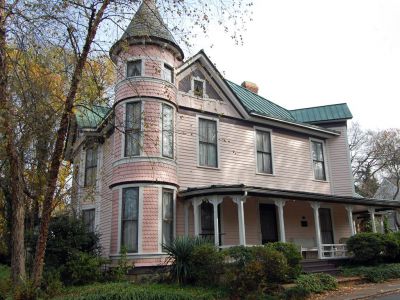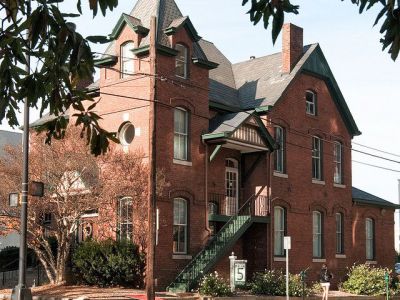Charlotte's Historical Buildings Tour (Self Guided), Charlotte
Downtown Charlotte or Uptown (as it is colloquially called by locals) is home to a number of historic structures that remind people what the city once looked like. Fourth Ward, Charlotte's oldest surviving downtown residential district filled with flowering plants, shrubs, evergreens, and tall deciduous trees, is long known for its well-preserved Victorian-era heritage.
Among its highlights, the Liddell-McNinch House stands out as an exquisite example of Queen Anne architecture. Built in the late 19th century, it showcases ornate detailing and a rather complex roofline. The John W Sheppard House is another gem of the Queen Anne style, with many of the era's features including the projecting bays, the dormer and its decorative details, and the cross-gables of the varied roofline.
The Eastlake Victorian Cottage is a charming structure characterized by intricate woodwork and vibrant colors. Meanwhile, the Newcomb-Berryhill House represents Italianate architecture with its elegant symmetry and ornamental brackets. The Crowell-Berryhill House, constructed in the Victorian style, features a rather simple and straightforward design, reflecting its utilitarian function.
The Overcarsh House is a well-preserved example of a late 19th-century farmhouse, showcasing a picturesque, conical-roofed turret at the corner facade, with the sunburst gables, bracketed front porch, and pineapple carving around the front door completing the exterior. Meanwhile, the Bagley Mullen House exhibits the Revivalist exterior manifested in its stately appearance.
Checking out the noteworthy buildings in Charlotte’s Uptown is bound to transport you back to the days long gone. Each of the local structures tells a unique story allowing you to immerse yourself in the city's eventful past. To fully appreciate these historical gems, consider taking our self-guided walking tour.
Among its highlights, the Liddell-McNinch House stands out as an exquisite example of Queen Anne architecture. Built in the late 19th century, it showcases ornate detailing and a rather complex roofline. The John W Sheppard House is another gem of the Queen Anne style, with many of the era's features including the projecting bays, the dormer and its decorative details, and the cross-gables of the varied roofline.
The Eastlake Victorian Cottage is a charming structure characterized by intricate woodwork and vibrant colors. Meanwhile, the Newcomb-Berryhill House represents Italianate architecture with its elegant symmetry and ornamental brackets. The Crowell-Berryhill House, constructed in the Victorian style, features a rather simple and straightforward design, reflecting its utilitarian function.
The Overcarsh House is a well-preserved example of a late 19th-century farmhouse, showcasing a picturesque, conical-roofed turret at the corner facade, with the sunburst gables, bracketed front porch, and pineapple carving around the front door completing the exterior. Meanwhile, the Bagley Mullen House exhibits the Revivalist exterior manifested in its stately appearance.
Checking out the noteworthy buildings in Charlotte’s Uptown is bound to transport you back to the days long gone. Each of the local structures tells a unique story allowing you to immerse yourself in the city's eventful past. To fully appreciate these historical gems, consider taking our self-guided walking tour.
How it works: Download the app "GPSmyCity: Walks in 1K+ Cities" from Apple App Store or Google Play Store to your mobile phone or tablet. The app turns your mobile device into a personal tour guide and its built-in GPS navigation functions guide you from one tour stop to next. The app works offline, so no data plan is needed when traveling abroad.
Charlotte's Historical Buildings Tour Map
Guide Name: Charlotte's Historical Buildings Tour
Guide Location: USA » Charlotte (See other walking tours in Charlotte)
Guide Type: Self-guided Walking Tour (Sightseeing)
# of Attractions: 7
Tour Duration: 1 Hour(s)
Travel Distance: 1.2 Km or 0.7 Miles
Author: leticia
Sight(s) Featured in This Guide:
Guide Location: USA » Charlotte (See other walking tours in Charlotte)
Guide Type: Self-guided Walking Tour (Sightseeing)
# of Attractions: 7
Tour Duration: 1 Hour(s)
Travel Distance: 1.2 Km or 0.7 Miles
Author: leticia
Sight(s) Featured in This Guide:
- Liddell-McNinch House
- John W. Sheppard House
- Eastlake Victorian Cottage
- Newcomb-Berryhill House
- Crowell-Berryhill House
- Overcarsh House
- Bagley Mullen House
1) Liddell-McNinch House
The historical Liddell-McNinch House was built between 1891 and 1893. This two-and-a-half-story structure is a prominent example of Queen Anne and Shingle Style architecture, blending tradition, whimsy, and period compositional principles.
Notable for its inventive architectural composition, the house boasts a highly complex roofline featuring projections, gables, porches, and expansive eaves, as well as wall surfaces of weatherboards, shingles, broken planes, swells, and cavities. In addition to its captivating mix of textures, patterns, and asymmetry, creating a picturesque silhouette, the exterior showcases a wraparound porch and a recessed porch on the second level.
The varied exterior is richly complemented by a lavish interior finish. Inside, the frame dwelling is equally ornate, with irregularly shaped rooms arranged from front to back. The oak woodwork, finished in a Neo-Federal style with classical elements, stands out for its robust and intricate carving.
The house was originally constructed for Charlotte businessman Vinton Liddell, in the early 1890s, and was later owned by Charlotte mayor Samuel S McNinch; hence the name.
US President William Howard Taft visited the house in 1909.
In 1976, the Liddell-McNinch House was listed on the National Register of Historic Places. Today it accommodates one of the city’s best restaurants.
Notable for its inventive architectural composition, the house boasts a highly complex roofline featuring projections, gables, porches, and expansive eaves, as well as wall surfaces of weatherboards, shingles, broken planes, swells, and cavities. In addition to its captivating mix of textures, patterns, and asymmetry, creating a picturesque silhouette, the exterior showcases a wraparound porch and a recessed porch on the second level.
The varied exterior is richly complemented by a lavish interior finish. Inside, the frame dwelling is equally ornate, with irregularly shaped rooms arranged from front to back. The oak woodwork, finished in a Neo-Federal style with classical elements, stands out for its robust and intricate carving.
The house was originally constructed for Charlotte businessman Vinton Liddell, in the early 1890s, and was later owned by Charlotte mayor Samuel S McNinch; hence the name.
US President William Howard Taft visited the house in 1909.
In 1976, the Liddell-McNinch House was listed on the National Register of Historic Places. Today it accommodates one of the city’s best restaurants.
2) John W. Sheppard House
The John W Sheppard House holds significant historical value in Charlotte and Mecklenburg County as one of the few Fourth Ward houses with its original site and orientation, constructed by businessmen of that era. The property was built by 1899 as the residence of John W Sheppard, one of the early university-trained professional pharmacists in the United States, who co-founded the Woodall and Sheppard Drugstore in 1896.
Architecturally, this townhouse is a prime example of the Free Classic, Queen Anne style prevalent throughout the late 19th century and, as such, offers valuable insights into the architectural history of Charlotte and the New South's prosperity during that period. Among other features, this Victorian-era home showcases projecting bays, dormers with decorative details, and varied rooflines. Its exterior boasts original horizontal board siding, Masonite siding, and wood shingles, reflecting the era's construction innovations and mass-produced materials.
Inside, the house's historic fabric remains largely intact and unaltered, with wood paneling, original pine moldings, wooden pocket door hardware, plaster walls, and 11-foot-high ceilings. Tiger oak and pine flooring add to the interior's charm. The stained glass windows feature an opalescent floral motif, and original gaslight-era sconces still adorn rooms and hallways.
The house remained in the Sheppard family until 1961. In 1991, it was converted into a bed-and-breakfast.
Architecturally, this townhouse is a prime example of the Free Classic, Queen Anne style prevalent throughout the late 19th century and, as such, offers valuable insights into the architectural history of Charlotte and the New South's prosperity during that period. Among other features, this Victorian-era home showcases projecting bays, dormers with decorative details, and varied rooflines. Its exterior boasts original horizontal board siding, Masonite siding, and wood shingles, reflecting the era's construction innovations and mass-produced materials.
Inside, the house's historic fabric remains largely intact and unaltered, with wood paneling, original pine moldings, wooden pocket door hardware, plaster walls, and 11-foot-high ceilings. Tiger oak and pine flooring add to the interior's charm. The stained glass windows feature an opalescent floral motif, and original gaslight-era sconces still adorn rooms and hallways.
The house remained in the Sheppard family until 1961. In 1991, it was converted into a bed-and-breakfast.
3) Eastlake Victorian Cottage
Another historic highlight in the Fourth Ward neighborhood is the Eastlake Victorian Cottage. This charming cottage is typical of the middle-class homes popular during the Victorian era and showcases the distinctive architectural style known as Eastlake or Eastlake Victorian.
The latter style emerged in the late 19th century and is characterized by ornate and decorative elements. Some common features of Eastlake architecture include intricate woodwork, spindlework, and vibrant paint colors. These elements are often used to adorn the home's exterior, particularly the porch and gables.
Indeed, as a prime example of this style, the Eastlake Victorian Cottage has a filigree decorative porch and delicate and elaborate woodwork, including spindle railings and decorative brackets. The use of lively colors on the exterior enhances the cottage's visual appeal and adds to its overall charm.
Originally, this beautiful light-blue home was built by Edward Latta in the Dilworth neighborhood to attract middle-class families. In 1977, the home was saved from demolition and moved to Fourth Ward for restoration during which a small second story was added.
The latter style emerged in the late 19th century and is characterized by ornate and decorative elements. Some common features of Eastlake architecture include intricate woodwork, spindlework, and vibrant paint colors. These elements are often used to adorn the home's exterior, particularly the porch and gables.
Indeed, as a prime example of this style, the Eastlake Victorian Cottage has a filigree decorative porch and delicate and elaborate woodwork, including spindle railings and decorative brackets. The use of lively colors on the exterior enhances the cottage's visual appeal and adds to its overall charm.
Originally, this beautiful light-blue home was built by Edward Latta in the Dilworth neighborhood to attract middle-class families. In 1977, the home was saved from demolition and moved to Fourth Ward for restoration during which a small second story was added.
4) Newcomb-Berryhill House
The Newcomb-Berryhill House is located on 9th Street in Charlotte's Historic Fourth Ward. It was built in 1884 by John H. Newcomb and his wife, Gussie. It represents the Victorian Italianate architectural style.
The Newcombs were important members of society in Charlotte. John, along with his brother, operated a bellows factory that quickly grew and expanded to include windows and sashes. Gussie, along with her sister, owned a very successful millinery.
The Newcomb's daughter, also named Gussie, married local grocer Earnest Berryhill. The two lived in the house at 9th Street, which is why it is referred to as the Newcomb-Berryhill House today. After the deaths of the Newcombs and Berryhills, the home was turned into an apartment complex. It declined over the years and was ultimately slated for demolition until the Junior League of Charlotte chose to purchase and restore it in 1975.
The home is now owned and preserved by Berryhill Preservation, Inc.
The Newcombs were important members of society in Charlotte. John, along with his brother, operated a bellows factory that quickly grew and expanded to include windows and sashes. Gussie, along with her sister, owned a very successful millinery.
The Newcomb's daughter, also named Gussie, married local grocer Earnest Berryhill. The two lived in the house at 9th Street, which is why it is referred to as the Newcomb-Berryhill House today. After the deaths of the Newcombs and Berryhills, the home was turned into an apartment complex. It declined over the years and was ultimately slated for demolition until the Junior League of Charlotte chose to purchase and restore it in 1975.
The home is now owned and preserved by Berryhill Preservation, Inc.
5) Crowell-Berryhill House
Alexander Michael's is a tavern in the Historic Fourth Ward of Charlotte. Visitors can stop by the tavern for lunch any day of the week. While they are there, they should take a moment to appreciate the history of the building.
The tavern is held in a building that is known by locals as the Crowell-Berryhill Store. It was originally a market. In fact, it is the only turn-of-the-century grocery store that is still standing in uptown Charlotte. The store opened in 1897 as part of the Star Mill Grocery Company, a grit and mill feed producer. It changed hands a number of times until it was eventually purchased by Earnest Berryhill in 1907. The store remained in use through the mid-20th century, and then went vacant and began to decline.
Luckily, an investment group chose to purchase the land and restore the property to its previous glory. Today, visitors can stop by to appreciate the restored craftsmanship while having a drink and a bite to eat.
The tavern is held in a building that is known by locals as the Crowell-Berryhill Store. It was originally a market. In fact, it is the only turn-of-the-century grocery store that is still standing in uptown Charlotte. The store opened in 1897 as part of the Star Mill Grocery Company, a grit and mill feed producer. It changed hands a number of times until it was eventually purchased by Earnest Berryhill in 1907. The store remained in use through the mid-20th century, and then went vacant and began to decline.
Luckily, an investment group chose to purchase the land and restore the property to its previous glory. Today, visitors can stop by to appreciate the restored craftsmanship while having a drink and a bite to eat.
6) Overcarsh House
Located at the corner of Pine and West Eighth Streets in Charlotte's Fourth Ward, the Overcarsh House is a remarkable two-story Queen Anne-style dwelling, one of the few remaining examples of this architectural style of the late 19th century in the Carolina Piedmont.
Named after the Overcarsh family, who occupied it for three generations, this historic home holds deep roots in Charlotte's history. Originally a modest two-room structure built in 1879, it underwent significant expansion and renovations initiated by the house's first owner, Methodist minister Elias Overcarsh, shortly after acquiring the property, resulting in its present appearance around 1900.
The rectangular frame house is sheathed in weatherboard, sits on a brick foundation, and has a hipped roof on the main block. The house exhibits distinctive Queen Anne features, including extended gable-roofed bays on its western and southwestern sides, a conical-roofed tower on the southeast corner, a shallow entrance but unusually large porch, and decorative gables, contributing to its irregular yet aesthetically pleasing design.
In 1966, the house left the Overcarsh family's possession but remained a vital part of Charlotte's historical landscape. Recognized for its architectural and historical significance, the Elias Overcarsh House received local historic property designation by the Charlotte Mecklenburg Historic Properties Commission in 1976. It was listed on the National Register of Historic Places in 1983.
Named after the Overcarsh family, who occupied it for three generations, this historic home holds deep roots in Charlotte's history. Originally a modest two-room structure built in 1879, it underwent significant expansion and renovations initiated by the house's first owner, Methodist minister Elias Overcarsh, shortly after acquiring the property, resulting in its present appearance around 1900.
The rectangular frame house is sheathed in weatherboard, sits on a brick foundation, and has a hipped roof on the main block. The house exhibits distinctive Queen Anne features, including extended gable-roofed bays on its western and southwestern sides, a conical-roofed tower on the southeast corner, a shallow entrance but unusually large porch, and decorative gables, contributing to its irregular yet aesthetically pleasing design.
In 1966, the house left the Overcarsh family's possession but remained a vital part of Charlotte's historical landscape. Recognized for its architectural and historical significance, the Elias Overcarsh House received local historic property designation by the Charlotte Mecklenburg Historic Properties Commission in 1976. It was listed on the National Register of Historic Places in 1983.
7) Bagley Mullen House
The Bagley-Mullen House is a majestic brick mansion located at Poplar and 5th Streets in Charlotte. It was built by Edward Andrews, who was somewhat known for erected impressive homes in the city.
The home is the only example of French Chateauesque architecture in the city. The Revivalist architecture of the house was inspired by Loire Valley chateaux. It is reminiscent of such august residences as Meillant and Courtalain.
The original occupant of the house was Andrew Bagley who quickly sold the house to Hornet's Nest Liniment inventor Walter Mullen. Today, the house is the location of a tattoo parlor. Prior to this it functioned as a day spa. The historic building remains intact for anyone who wants to stop by and see the beautiful architecture.
The Bagley-Mullen House is located within easy walking distance of Discovery Place, Saint Peter's Episcopal Church and a large number of historic buildings in the Fourth Ward.
The home is the only example of French Chateauesque architecture in the city. The Revivalist architecture of the house was inspired by Loire Valley chateaux. It is reminiscent of such august residences as Meillant and Courtalain.
The original occupant of the house was Andrew Bagley who quickly sold the house to Hornet's Nest Liniment inventor Walter Mullen. Today, the house is the location of a tattoo parlor. Prior to this it functioned as a day spa. The historic building remains intact for anyone who wants to stop by and see the beautiful architecture.
The Bagley-Mullen House is located within easy walking distance of Discovery Place, Saint Peter's Episcopal Church and a large number of historic buildings in the Fourth Ward.
Walking Tours in Charlotte, North Carolina
Create Your Own Walk in Charlotte
Creating your own self-guided walk in Charlotte is easy and fun. Choose the city attractions that you want to see and a walk route map will be created just for you. You can even set your hotel as the start point of the walk.
Historical Churches
Charlotte, North Carolina, is home to a variety of religious sites, representing a range of religious denominations. The city's historical churches date mostly to the first half of the 19th century and stand as both spiritual sanctuaries and architectural landmarks.
One of the notable places of worship in Charlotte is Saint Peter's Catholic Church. Founded in 1851, it boasts a... view more
Tour Duration: 1 Hour(s)
Travel Distance: 1.9 Km or 1.2 Miles
One of the notable places of worship in Charlotte is Saint Peter's Catholic Church. Founded in 1851, it boasts a... view more
Tour Duration: 1 Hour(s)
Travel Distance: 1.9 Km or 1.2 Miles
Charlotte Introduction Walking Tour
The city of Charlotte was settled by Europeans from Northern Ireland around 1755. Its namesake was Charlotte of Mecklenburg-Strelitz, wife of King George III and Queen of Great Britain and Ireland. It was from this name that Charlotte earned its nickname "The Queen City."
Another nickname of Charlotte is "The Hornet's Nest," which originated during the American... view more
Tour Duration: 1 Hour(s)
Travel Distance: 2.2 Km or 1.4 Miles
Another nickname of Charlotte is "The Hornet's Nest," which originated during the American... view more
Tour Duration: 1 Hour(s)
Travel Distance: 2.2 Km or 1.4 Miles
The Most Popular Cities
/ view all



